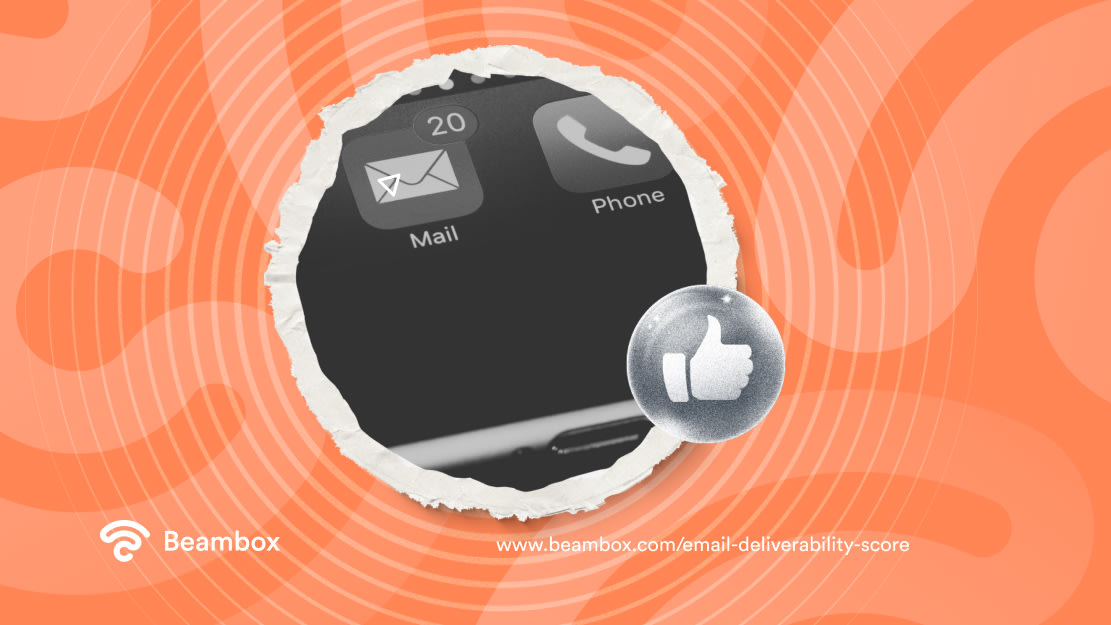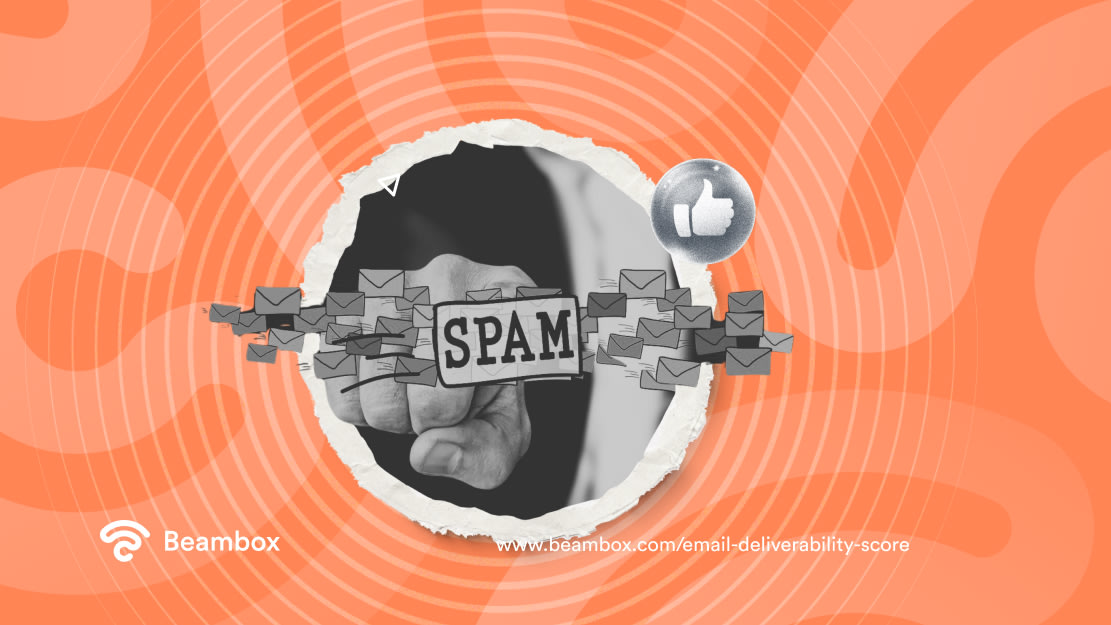Email Deliverability Score: How To Improve It
The success of your email marketing campaigns depends significantly on your email deliverability score. After all, your subscribers can’t engage with your campaigns if they can’t see them.
Achieving a good deliverability score may seem easy at first, but obstacles can prevent marketing wins from coming your way. In today’s guide, we’ll help you navigate these obstacles with helpful score-boosting strategies that will improve your email campaigns!

What Is an Email Deliverability Score?
To understand these all-important scores, you need to first learn what email deliverability actually is.
Email deliverability refers to the ability to deliver emails that reach the target recipients’ (subscribers) inboxes. For good deliverability, you’re aiming to reach the recipients’ primary, social, or promotional inboxes while bypassing the dreaded spam filters.
So, an email deliverability score is simply a useful metric. It measures how likely it is that your emails find their way to the right places.
You’ll always want the highest score you can get to prevent your emails from reaching the recipient’s spam folder. We don’t need to tell you how emails in the spam inbox are rarely opened, let alone read.
Needless to say, a low deliverability score tells you that you have some deliverability issues that you’ll need to rectify. Ultimately, your email marketing campaigns could be absolutely perfect, but they would be ineffective without a high deliverability score.
Having high scores means that your campaigns are visible and, thus, much likelier to increase customer engagement. Of course, more engagement means higher conversion rates, maximized ROI, reinforced credibility, and better brand-customer relationships.
How Is Email Deliverability Score Calculated?
Knowing how important your deliverability scores are, you’ll want to know how you can calculate them. We can’t give you a one-size-fits-all formula, but we can tell you about the factors that will affect your scores.

Sender Reputation
Your sender reputation, or score, has a significant influence over your deliverability score, as it reflects your brand’s trustworthiness. You should know that your email service provider (ESP) determines your sender reputation.
When your sender reputation isn’t great, it’s your ESPs that stop your email from reaching your target recipient. With that in mind, you must know how your ESPs assign you your sender score: your IP and domain reputation.
IP reputation is a measure that assesses an IP address’s trustworthiness based on the number of unsolicited emails it sends. Let’s say your IP address demonstrates characteristics like high email volume, high bounce rates, and high spam complaint rates. The result: your IP address will have a poor IP reputation.
Your domain reputation is very similar to your IP reputation - it still evaluates trustworthiness - only with some important distinctions. Spam complaints and bounce rates will still affect your domain reputation, but so will domain age and poor engagement rates.
Domain reputation also concerns itself directly with your business’s domain and, thus, takes longer to build than your IP reputation.
What’s more, IP reputation is specific to a particular IP address, which makes improving your IP reputation much simpler. You can simply change your IP address. In contrast, your domain address sticks with your business regardless of such changes.
Both reputations impact your sender score and, subsequently, your deliverability score.
Engagement Metrics
One of the biggest email marketing mistakes you could make is ignoring your engagement metrics. The engagement metrics we’ve listed below will play a large role in your deliverability scores.
- Email Open Rates: These rates appear as percentages. They reveal the ratio of opened emails to the number of how many emails you initially sent. Let’s say you distribute 100 emails, but only 40 were opened: you’d have an open rate of 40%.
- Click Through Rate (CTR): Your campaign’s CTR tells you how many recipients clicked on a link within a specific email.
- Email Response Rate: Another percentage for you! These rates reveal the amount of emails that you sent that got a response from the recipient. This amount is then measured against the total number of distributed emails.
- Conversion Rates: Conversion rates measure the percentage of recipients that take a specific action that’s specified in an email. You’d divide your successful conversions by the total number of sent emails.
All of these metrics show you that your subscribers derive value from your emails. When these metrics increase, so will your deliverability score.

Negative Metrics
There are also other metrics that no business wants to see increase. That said, it’s worth knowing what they are, as they also have some sway over your deliverability score.
- Bounce Rates: Email bounce rates refer to the percentage of emails that didn’t reach their target recipients. Instead, these emails go back to the sender.
- Unsubscribe Rates: These rates show how many recipients opt out of your email marketing campaigns.
- Spam Complaint Rates: Spam complaint rates tell you the number of recipients who flagged your email as spam.
- Email Churn Rate: Churn rates reveal how many of your recipients unsubscribe from your email list over time.
Authentication Protocols
Email authentication is good for your online reputation, reducing deliverability issues and improving your sender’s reputation. Authentication protocols ensure that your emails are legitimate, and there are three major protocols you should know about.
- Sender Policy Framework (SPF): This protocol verifies that a mail server has the authority to send emails from your domain.
- DomainKeys Identified Mail (DKIM): This protocol uses digital signatures to protect your domain from email spoofing. It also prevents anyone from altering an email that’s in transit.
- Domain-Based Message Authentication, Reporting, and Conformance (DMARC): Although a mouthful, DMARC is invaluable. It’s a protocol that enables you to identify and prevent email spoofing attacks and phishing scams. It also allows you to tell a mail server what to do when an email fails SPF and DKIM checks.

How To Improve Your Email Deliverability/Sender Score
Let’s get down to brass tacks: how to keep your email deliverability and sender scores sky-high. Follow our tips below, and your emails will always reach your target recipients.
- Set up/configure the key authentication protocols we mentioned earlier (SPF, DKIM, and DMARC).
- Frequently clean your mailing list and reduce your bounce rate by removing inactive, invalid, and disengaged subscribers.
- If you plan to send a large number of emails, opt for a dedicated IP address.
- Devise and maintain a consistent email-sending schedule to avoid appearing suspicious to your ESPs.
- Leverage A/B tests to uncover the most engaging subject lines for your emails.
- Warm up your IP address by methodically and gradually increasing the number of emails you send to your mailing list. This will help you earn the trust of your internet service providers (ISPs).
- Check email blacklists to ensure you have no IP or domain reputation issues prior to sending out your email campaigns.
- Avoid purchasing email lists to dodge spam traps.
- Perfect the design and content of your marketing emails to boost your engagement metrics and deliver value to your recipients.
- Prioritize mobile responsiveness in your email designs.
- Utilize double opt-ins, which ask recipients to confirm their email addresses and interests before adding them to your mailing list. This will help you maintain an email list of engaged subscribers.

How Do You Check Email Deliverability Scores?
After making some improvements to your deliverability score, you’ll need some email checker tools to verify your new deliverability score. To point you in the right direction, we’ve listed some helpful tools below, such as:
- ZeroBounce
- GlockApps
- Validity Everest
- Warmy
- Lemwarm
- MxToolbox
- Litmus Software
- MailReach
- InboxAlly
- Folderly
Boosting Your Email Deliverability Score: Let Beambox Help
Mastering deliverability scores is one-half of the battle. The other half is all about optimizing the content within your email campaigns. For that, you’ll need Beambox.
With Beambox, you’ll reshape your approach to engaging your guests with our reliable WiFi marketing solutions. While your guests enjoy speedy, secure WiFi, you’ll collect a trove of customer data to enrich your targeted advertising.
The data you collect will allow you to segment your target recipients, enabling you to create more personalized campaigns. We even offer exceptional design features, allowing you to distribute stunningly designed emails that will captivate your guests.
We won’t just help you improve your email deliverability score; we’ll help you garner glowing reviews and refashion customer experiences. Start your free trial with Beambox today and take your email marketing campaigns to the next level!
FAQs
Why is my email deliverability score important?
Your email deliverability score is crucial for the success of your email campaigns. This score measures how likely it is that your emails will reach the recipient’s inbox and not their spam folder.
What is a good deliverability rate for email campaigns?
A good deliverability rate ranges between 89% and 98%. If your deliverability rates were less than 70%, your email campaign likely needs some work.
How is the sender score calculated?
Your sender score is based on several factors, including domain reputation, spam complaints, bounce rates, and email engagement.



